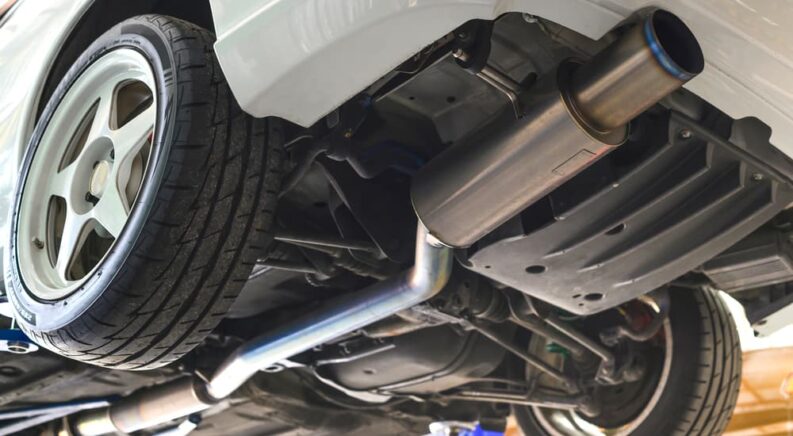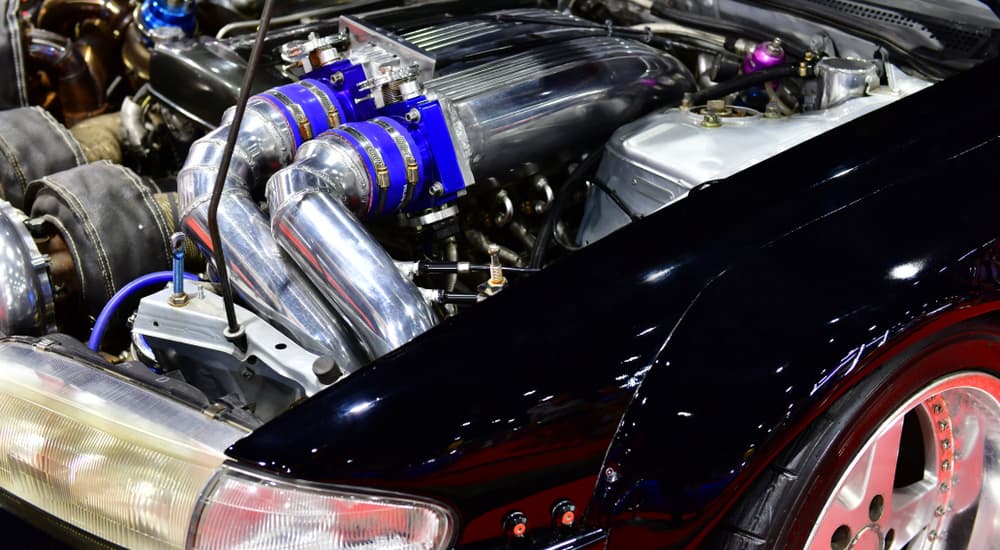Pull up to any shop specializing in auto repair, and you’re bound to be met with cars, trucks, and SUVs in various states of disrepair. From dented bumpers and scratched body panels to crumpled hoods and totaled chassis, these vehicles have seen better days. Then there are the relatively pristine models that look no worse for wear. While these look structurally sound, they don’t look like anything you’ve actually seen on the road—their parts don’t seem like they add up to a cohesive whole. What’s the deal? They could be suffering from a simple case of over-modification.
The urge to upgrade and personalize one’s ride is as old as car culture itself, but getting a little overzealous can easily result in a vehicle that spends more than its fair share of time waiting to go up on the mechanic’s lift. Don’t get us wrong, there are some modifications that make a lot of sense when you’re looking to upgrade a vehicle’s power, performance, or style, but it’s always good to know which ones can be safely embraced and which shouldn’t be touched with a 10-foot pole. In an effort to keep you out of the mechanic’s waiting room, we’ve compiled a short list of some of the key factors you should consider before launching into your next car modification project. From impacting warranty coverage and safety to resale value and even legality, we’ll see how too much of a good thing can turn bad in a hurry.
Safety
When modifying their vehicles, most drivers tend to prioritize performance over safety. A vehicle’s chassis, suspension, and all associated parts have been thoroughly tested to ensure the best possible performance in crash or accident scenarios, but modifications can have a serious impact on their overall safety. Say you’re looking to gain a little extra ground clearance with some upsized wheels and tires. Assuming you have enough room in the wheel wells, this is a relatively easy upgrade, but even a slightly larger wheel can throw a vehicle’s suspension dynamics all out of whack while also impacting the handling and required braking power. Even the most seemingly benign modifications, like fitting your seat with aftermarket seat covers, can impact overall safety if they affect the performance of something like seat-mounted side-impact airbags.
Improperly installed modifications can also pose a real safety risk. While we’ve all felt the urge to save a little money by going the DIY route, it’s not always the best idea, especially when you’re dealing with vital performance—or safety-related parts. This is especially true of modifications that involve electrical wiring or anything that impacts the engine, suspension, or safety systems. Even if you don’t have a professional perform the installation of a new aftermarket part, it’s always a good idea to stop by a trusted local mechanic to have them give your handiwork a once-over. That seal of approval isn’t just good for a little validation; it can also make a big difference in your vehicle’s long-term safety.
Insurance
Proper insurance coverage is a vital part of vehicle ownership, but it can become a little complicated—and expensive—when you start diving into the world of modifications. We all know that insurance companies consider a wide range of factors like age, driving habits and record, location, and usage before setting a rate for coverage, but few drivers realize that modifications can also affect the price.
Insurers tend to include a vehicle’s market value, performance, and likeliness of being involved in an accident when factoring rates. When a vehicle hasn’t been modified, this is as easy as cross-referencing data from customers driving the same make and model, but modifications can cause this simple formula to be thrown out of the window. Once any modifications are made, insurance companies can’t just assume that a vehicle will perform the same when it comes to safety and accident prevention, which often results in higher rates. It’s what’s known as a risk profile, and it’s a term that you should become well-acquainted with before splashing some cash on that next modification. Take a suspension lift, for example. This modification is especially popular with those trying to create an off-road pickup or SUV, but it can also affect stability and raise a vehicle’s center of gravity, making it easier to tip over. These are the types of factors an insurance company has to consider when setting rates, so it’s usually best not to give them any excuse to raise yours.
While you might assume these higher insurance rates are only an issue when it comes to performance-related modifications like a larger engine, a lifted or lowered extension, or an overhauled exhaust, that’s not always the case. Any modification that makes a vehicle more attractive to potential thieves, such as a new stereo, a flashy paint job, or premium interior accessories, can also cause your insurance rates to jump.
Legality
Certain modifications are a bad idea, but some are downright criminal. While these are mostly limited to appearance- and emissions-related mods, it’s important to err on the right side of the law when it comes to any upgrades you might perform on your vehicle unless you want to end up with a hefty ticket. Most states have some emissions-related legislation that makes it illegal to modify your exhaust in a way that circumvents or eliminates your catalytic converter. An exhaust cutout, which bypasses the muffler to create a louder exhaust noise, is also illegal in many jurisdictions.
Then there are the appearance-related mods. From off-color headlights, turn signals, and side marker lights to underbody lights and tinted windows that restrict more than 70 percent of light, the list of prohibited styling mods is longer than you might think. While the actual danger of some of these mods might be questionable at best, the law is the law, so take note.
Inappropriate Parts
Not all car parts are created equal. While there are plenty of companies producing high-quality aftermarket car parts and accessories, there are also a distressing number of fly-by-night operations just looking to make a quick buck. Failure to avoid the latter can result in some serious consequences, so quality and performance should take precedence over price when it comes to modifying your ride. Also, beware of refurbished parts—a freshly scrubbed component could hide a serious flaw or some significant wear and tear.
It’s also easy to stray in the other direction and load your vehicle down with parts that have no place on a daily driver or non-track vehicle. While it can be fun to run your car on the same tires, wheels, or brakes that the pros use, it can often stray into the realm of overkill. These high-performance parts are designed to work on smooth, pristine tracks in high-stress scenarios, which is a little different than the morning school drop-off run.
We’ll use the brake pads to illustrate our point. The performance pads found on track vehicles and street racers are designed to operate at very high temperatures that the average vehicle will rarely reach. When installed on a daily driver, these pads will have difficulty heating up to the point where they’re operating in the ideal temperature range, creating all sorts of problems when it comes to performance. This means that, during the course of your daily driving, the brake pads will actually be less effective than the garden variety pads found on most everyday vehicles. “High-performance” doesn’t always mean better.
Warranty
Diving into the world of car modifications without doing your research is a great way to void a vehicle’s warranty. The generous warranties offered with many of today’s vehicles offer free or low-cost replacement of some of the most vital and expensive powertrain components, but if you get a little overzealous with modifications, it’s all too easy to find yourself paying out of pocket.
Maybe you want to gain a little extra height with some upsized tires or wheels, for example. This might give your car, truck, or SUV the towering look you were after, but as we mentioned above, overly large tires and wheels can also brush up against the vehicle’s body or impact the suspension, brakes, or other vital systems. Engine and suspension upgrades carry the same risks, which is why it’s always a good idea to review the terms of your warranty before launching into a modification project. Many automakers will provide a list of warranty-safe modifications, but when in doubt, consult the manufacturer or an authorized dealer directly.
Value
In some cases, modifications aren’t just expensive; they can impact the value of the vehicle itself. This might seem a little backwards, as a vehicle loaded up with aftermarket parts should—in theory—command a higher price on the open market, but it all comes down to a matter of taste. That flaming paint job, eight-ball gear shifter, and those chromed-out rims might fit your own personal style, but they could also seriously limit your vehicle’s resale value when it comes time to part with it. Even if a driver shares your sense of automotive style, the workmanship might not always be up to snuff, leading them to seek a model modified by a professional.
Performance modifications are no different. An upgraded exhaust or cold-air intake can go a long way toward improving performance, but if the buyer is just looking for a reliable daily driver, it might be a bit much. As a rule of thumb, never assume you’ll recoup your investment when it comes to aftermarket modifications. A buyer will have a tough time comparing your vehicle with similar models on the open market due to the modifications, which makes it tough to set a fair price that will leave all parties satisfied.
Modifying your vehicle is an easy way to make it your own, improve performance, or just turn a few heads, but knowing what you’re getting yourself into is important. A properly modified vehicle can blow most stock models away with its one-of-a-kind looks and upgraded components, but you always run the risk of going a little overboard. Between increased insurance rates, resale value, warranty coverage, and legality, there are some significant pitfalls to avoid when modifying your ride. As we mentioned earlier, it’s always a good idea to discuss any modifications with a professional or, at the very least, have them review your work once the project is complete. If you do over-modify your vehicle, it’s not the end of the world. In most cases, your work can easily be reversed, but it’s always a better idea to just try to get it right the first time around.






